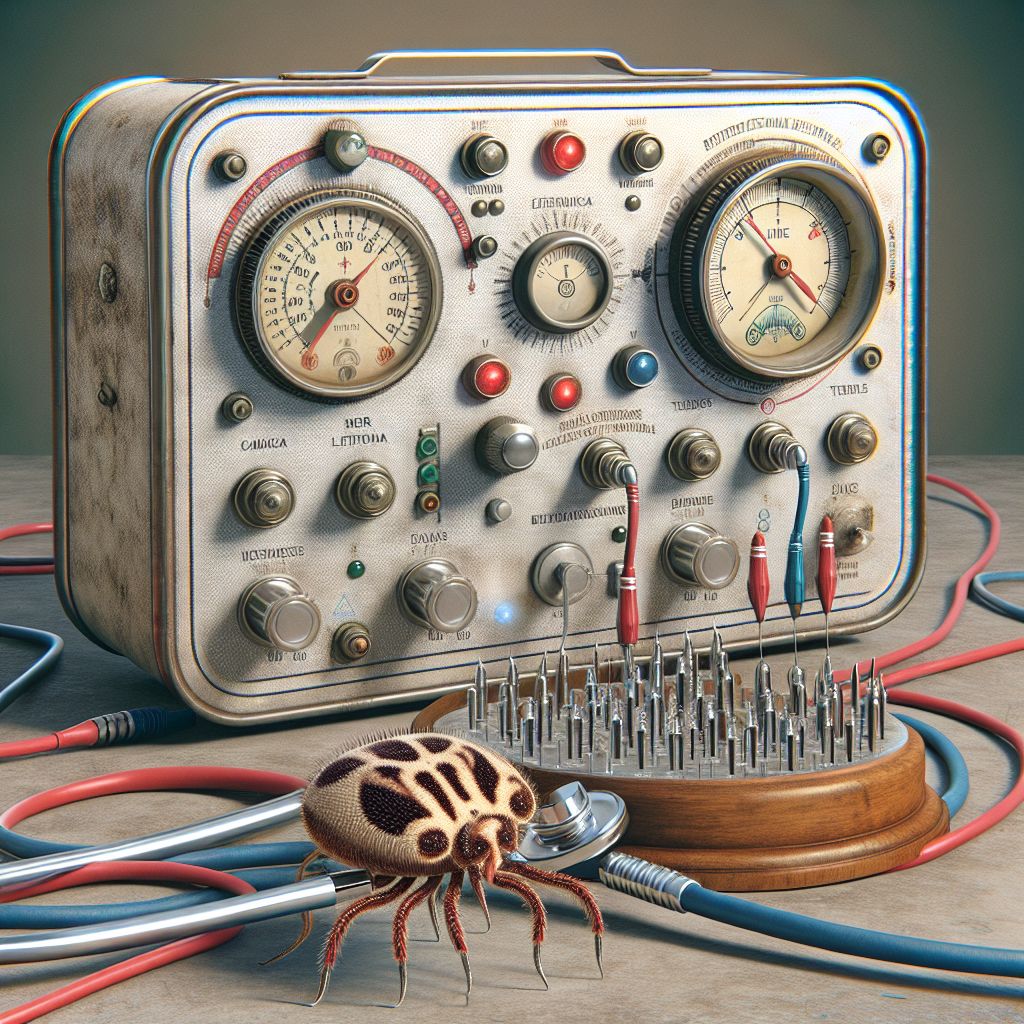-
Rife machines claim to treat Lyme disease by using electromagnetic frequencies.
-
The effectiveness of Rife machines for Lyme disease is based on anecdotal evidence, not scientific studies.
-
Understanding how to use a Rife machine properly is crucial for safety and potential effectiveness.
-
Potential risks and legal considerations should be taken into account before starting Rife machine therapy.
-
Complementary therapies may enhance the potential benefits of using a Rife machine for Lyme disease.

The Controversy Surrounding Rife Machines
Over my four decades of practicing family medicine with a focus on natural remedies, and more than two decades treating Lyme disease with natural approaches I’ve come across a variety of unconventional treatments. One such treatment that often sparks debate is the use of Rife machines for conditions like Lyme disease. Let me walk you through what I’ve learned and observed about this intriguing approach.
The FDA Stance on Electromagnetic Therapy
The Food and Drug Administration (FDA) has not approved Rife machines for the treatment of Lyme disease or any other condition. This stance is based on a lack of scientific evidence supporting the efficacy of these devices. As a healthcare provider, I am limited to offering treatments that have FDA approval as it assures a certain level of safety and effectiveness for medical treatments. However, lack of FDA approval doesn’t mean the idea doesn’t work. It just means the evidence wasn’t sufficient to grant approval. This is a common dilemma for many therapeutics in the natural world because the promoter or inventor often does not have the means to fund a study that would prove the point. Nevertheless, anecdotes often point the way to the truth.
Alternative Practitioners and Rife Machine Prescriptions
Despite the FDA’s position, some alternative healthcare practitioners advocate the use of Rife machines. They argue that the electromagnetic frequencies can target and eliminate the bacteria responsible for Lyme disease. While I understand the desire to explore all possible avenues for relief, I also stress the importance of taking advantage of treatments that have undergone rigorous testing and validation. However in Lyme disease, no treatment has received this kind of scrutiny.
Legal Aspects and Accessibility Issues
The legal landscape surrounding Rife machines is complex. Selling or marketing these devices as medical treatments without FDA approval is illegal in the United States. However, individuals may use these machines for personal use at their own risk. Because of these legalities, accessibility can be challenging, and I caution patients to be fully informed before considering such therapies.
Understanding the Rife Machine
The Historical Background of Royal Rife’s Invention
In the 1930s, Royal Raymond Rife, an American scientist, invented the Rife machine. Rife believed that he could destroy pathogens, including bacteria and viruses, by bombarding them with frequencies specific to each organism. Over time, his ideas gained a following among those seeking alternative treatments.
How the Rife Machine Claims to Work
Proponents of the Rife machine suggest that every organism has a specific electromagnetic frequency, and that exposing these organisms to their resonant frequency will disrupt or destroy them without affecting the surrounding healthy tissue. For Lyme disease, the theory is that the machine can target the Borrelia burgdorferi bacteria specifically.
Key Components of the Rife Machine
A typical Rife machine consists of a frequency generator and a delivery system, such as electrodes or plasma tubes. The generator is programmed with specific frequencies believed to be resonant with various pathogens. Users apply these frequencies to their body in the hope of treating their ailments.
“I’ve seen patients who swear by the relief they’ve found through Rife machines, while others have not experienced any benefit. It’s a deeply personal journey that requires careful consideration and often, a leap of faith. In the patients I have personally followed more than 50% get a good result from the treatment.”
Documenting Patient Responses to Rife Therapy
Over the years, I’ve encountered a spectrum of responses from patients using Rife machines for Lyme disease. Some report significant improvements, describing reductions in joint pain, increased energy, and better cognitive function. Others, however, don’t notice any change. It’s important to document these experiences to understand the potential impact of Rife therapy better, but remember, these are personal accounts, not scientific proof. However the beginning of any real therapy that improves symptoms always starts with anecdotal experiences. That’s where Rife machine use for Lyme has been for a long time but the reasons of the cost of funding studies mentioned above.
Comparing Rife with Traditional Lyme Disease Treatments
Traditional Lyme disease treatments typically involve antibiotics, which are the standard medical approach to bacterial infections. In contrast, Rife machines offer a non-pharmaceutical alternative by using electromagnetic frequencies. While antibiotics have a proven track record supported by clinical research, Rife therapy’s evidence is primarily anecdotal. But just like there are failures with Rife therapy, there are plenty of failures with
How to Use the Rife Machine for Lyme Disease
Using a Rife machine requires more than just flipping a switch. It’s a process that involves proper setup, understanding the technology, and a commitment to a treatment schedule. Before starting, make sure to consult with a healthcare professional who is knowledgeable about Rife therapy and Lyme disease.
Setting Up the Rife Machine: A Step-by-Step Guide
To start with Rife therapy, you’ll need to set up your machine correctly. Begin by connecting the power source and turning on the machine. Next, enter the specific frequencies recommended for Lyme disease treatment into the machine’s frequency generator. These frequencies can usually be found in the Rife machine’s manual or from a practitioner who has experience with Rife therapy. Lastly, position the electrodes or plasma tubes as instructed, ensuring they are in contact with your skin or close to your body.
It’s crucial to follow the manufacturer’s guidelines and safety instructions to avoid any potential risks. Improper use of the machine can lead to unintended consequences.
“Always remember, precision in setting up the Rife machine is key to its potential success. Do not rush the process, and make sure every step is performed with care and accuracy.”
Creating a Treatment Schedule: Frequency and Duration
Once your Rife machine is set up, you’ll need to determine how often and for how long you should use it. This is where it gets a bit tricky, as there’s no one-size-fits-all schedule. Treatment frequency and duration can vary based on the individual’s condition and the specific frequencies used. Some general guidelines suggest starting with shorter sessions and gradually increasing as tolerated, but always consult with a practitioner first.
For instance, you might start with sessions of 15 minutes, three times a week, and slowly increase to 30 minutes, if comfortable. Always listen to your body and adjust accordingly.
-
Start with shorter sessions (e.g., 15 minutes).
-
Gradually increase duration as tolerated.
-
Consider frequency (e.g., three times a week).
-
Adjust based on personal comfort and response.
Tips for Monitoring Progress and Managing Herxheimer Reactions
Monitoring your progress is crucial when using a Rife machine for Lyme disease. Keep a journal to note any changes in symptoms, both positive and negative. This can help you and your healthcare provider make informed decisions about continuing or adjusting your treatment plan.
Be aware of Herxheimer reactions, which are detoxification reactions that can occur when large quantities of pathogens are killed off quickly. Symptoms might include flu-like symptoms, fatigue, or new or worsening symptoms. If you experience a Herxheimer reaction, consider reducing the frequency or duration of your Rife machine sessions and consult with your healthcare provider.
Risk Factors and Considerations
While Rife machines are generally considered safe by those who use them, it’s important to be aware of potential risks. These might include electrical hazards, improper use leading to physical discomfort, or interference with other medical devices. Always use the machine according to the manufacturer’s instructions and under the guidance of a knowledgeable practitioner.
Who Should Avoid Using the Rife Machine
Certain individuals should be cautious or avoid using Rife machines altogether. This includes those with pacemakers, pregnant women, and individuals with a history of seizures. The electromagnetic frequencies could interfere with pacemakers, and the effects on pregnancy and seizure disorders are not well understood.
How to Approach Rife Machine Therapy Safely
To approach Rife machine therapy safely, start by consulting with a healthcare provider who understands both Lyme disease and Rife therapy. Ensure you have a proper diagnosis and consider Rife therapy as part of a broader treatment plan. Use the machine as directed and stay alert to your body’s responses, adjusting treatment as necessary.
Empirical Evidence and Research
Scientific evidence supporting the use of Rife machines for Lyme disease is scarce. Most of the available information comes from personal testimonials and anecdotal reports. For a treatment to be widely accepted in the medical community, it must undergo rigorous testing through clinical trials and peer-reviewed studies, which has not been the case for Rife therapy. However I have many patients who have improved in their symptoms using this technique. I personally believe it works after seeing many patients with documented Lyme using the Rife therapy.
Studies and Clinical Trials: What Science Says
There is a lack of clinical trials and scientific studies specifically investigating the use of Rife machines for Lyme disease. This absence of empirical evidence makes it difficult to assess the therapy’s efficacy and safety comprehensively. While some preliminary research into electromagnetic therapy exists, it is not sufficient to draw definitive conclusions.
Analysing the Data: Success Rates and Limitations
Due to the lack of scientific studies, success rates for Rife machine therapy in Lyme disease are not well-documented. It’s also challenging to determine the limitations and potential of the treatment. Until more research is conducted, the medical community remains skeptical, and patients are encouraged to approach Rife therapy with caution and informed decision-making.
Spotlight on Promising Case Studies
In my practice, I’ve come across several case studies that shed a positive light on the use of Rife machines. For example, one of my patients with chronic Lyme disease reported a significant decrease in joint pain and fatigue after consistent Rife treatments over several months. While these stories are encouraging, it’s essential to recognize that they do not constitute clinical evidence.
Complementary Therapies and the Rife Machine
Integrating Rife with Holistic Lyme Disease Approaches
When considering the use of a Rife machine, it’s not just about the device itself. It’s about the broader context of an individual’s health. I always encourage patients to take a holistic approach to their Lyme disease treatment, which means looking at the whole picture, including diet, stress management, and other lifestyle factors.
The Role of Diet and Lifestyle Changes in Conjunction with Rife Therapy
Diet and lifestyle changes can play a significant role in managing Lyme disease symptoms and may complement Rife therapy. For instance, exploring the effect of a carnivore diet on the symptoms of Lyme disease can provide insights into how nutritional choices impact overall health.
-
Eating a nutrient-rich diet can support immune function.
-
Reducing sugar intake (ideally eliminating processed sugar) may help to decrease inflammation.
-
Engaging in regular gentle exercise can improve circulation and detoxification.
These lifestyle modifications, alongside Rife therapy, could potentially create a more conducive environment for healing.
Moreover, stress reduction techniques such as meditation or prayerful meditation can be beneficial. Stress can weaken the immune system, making it harder to fight infections, including Lyme disease.
Finally, ensuring adequate sleep is crucial for recovery. Sleep is when the body repairs itself, so good sleep hygiene can support the treatment process.
“In my experience, patients who combine Rife therapy with positive lifestyle changes often report better outcomes than those who rely on the Rife machine alone.”
Other Alternative Therapies Compatible with Rife Treatment
Beyond diet and lifestyle, other alternative therapies may be used in conjunction with Rife treatment. These include herbal supplements, acupuncture, and homeopathy. Each of these therapies has its own set of potential benefits and should be considered within the context of an individual’s unique health situation.
What to Expect During Rife Therapy
Entering into Rife therapy can be a journey into the unknown for many. Understanding what to expect can help alleviate concerns and set realistic expectations.
Typical Therapy Sessions: Duration, Sensations, and Immediate Effects
A typical Rife therapy session may last anywhere from 15 minutes to an hour, depending on the individual’s tolerance and the specific protocol being followed. Some people report feeling a warming sensation or a slight tingling during treatment, while others feel nothing at all. Immediate effects vary widely; some may feel energized, while others may feel tired or experience a temporary increase in symptoms due to the Herxheimer reaction.
It’s important to note that Rife therapy is not a quick fix. Some individuals may require several sessions before noticing any potential benefits.
“Patience is key with Rife therapy. It’s a process that may take time, and effects can be subtle at first.”
After a Rife session, it’s common to feel a bit more fatigued as the body processes the treatment. Drinking plenty of water and resting can help manage this.
-
Session duration can vary from 15 minutes to an hour.
-
Sensations during treatment can include warmth or tingling.
-
Immediate effects range from feeling energized to increased fatigue.
Navigating the Healing Process: From Detox to Recovery
The healing process can be a roller coaster, especially with a condition as complex as Lyme disease. Detoxification reactions, such as the Herxheimer response, can be part of the journey. These reactions can be uncomfortable, but they are often a sign that the body is working to eliminate toxins and pathogens.
It’s crucial to have support during this time, whether from healthcare providers, family, or Lyme disease support groups. They can provide guidance, reassurance, and practical tips for managing symptoms.
Post-Treatment: Maintenance and Long-Term Health Strategies
After completing a course of Rife therapy, maintaining the potential gains is important. Continuing with a healthy diet, regular exercise, stress management, and routine check-ups can help sustain any improvements in symptoms.
Some patients choose to continue with occasional Rife sessions as a preventive measure or whenever they feel a flare-up of symptoms. Others may turn to different modalities to support their long-term health.
-
Continue with healthy lifestyle choices post-treatment.
-
Consider routine check-ups to monitor Lyme disease status.
-
Use Rife therapy as needed, based on personal health and symptoms.
In conclusion, while Rife machines offer an intriguing option for those seeking alternative Lyme disease treatments, it’s essential to approach this therapy with caution, thorough research, and professional guidance. Combining Rife therapy with a holistic approach to health can potentially offer the best chance for improvement. Remember, empowering healthful living choices means taking charge of your health journey and making informed decisions that align with your values and well-being.
As a family doctor with over 40 years of experience and more than 20 years of treating Lyme disease naturally, my goal has always been to guide patients towards treatments that support their overall health and to navigate the myriad of options available with wisdom and care. Whether you choose to explore Rife machine therapy or another path, I’m here to support you on your journey to wellness.
What is a Rife machine, and is it helpful?
Mar 17, 2021 — Rife machines were invented in 1920’s by Royal Raymond Rife. They…
Rife frequency devices and Lyme. – Document – Gale Academic OneFile
by J Klotter · 2007 — Health group (http://health.groups.yahoo.com/group/Lyme-an…
The Rife Machine: The Next Wave in Lyme Treatment?
By Sharon Cardel. The CDC estimates that some 300,000 people will contract Lyme …


Leave a Reply